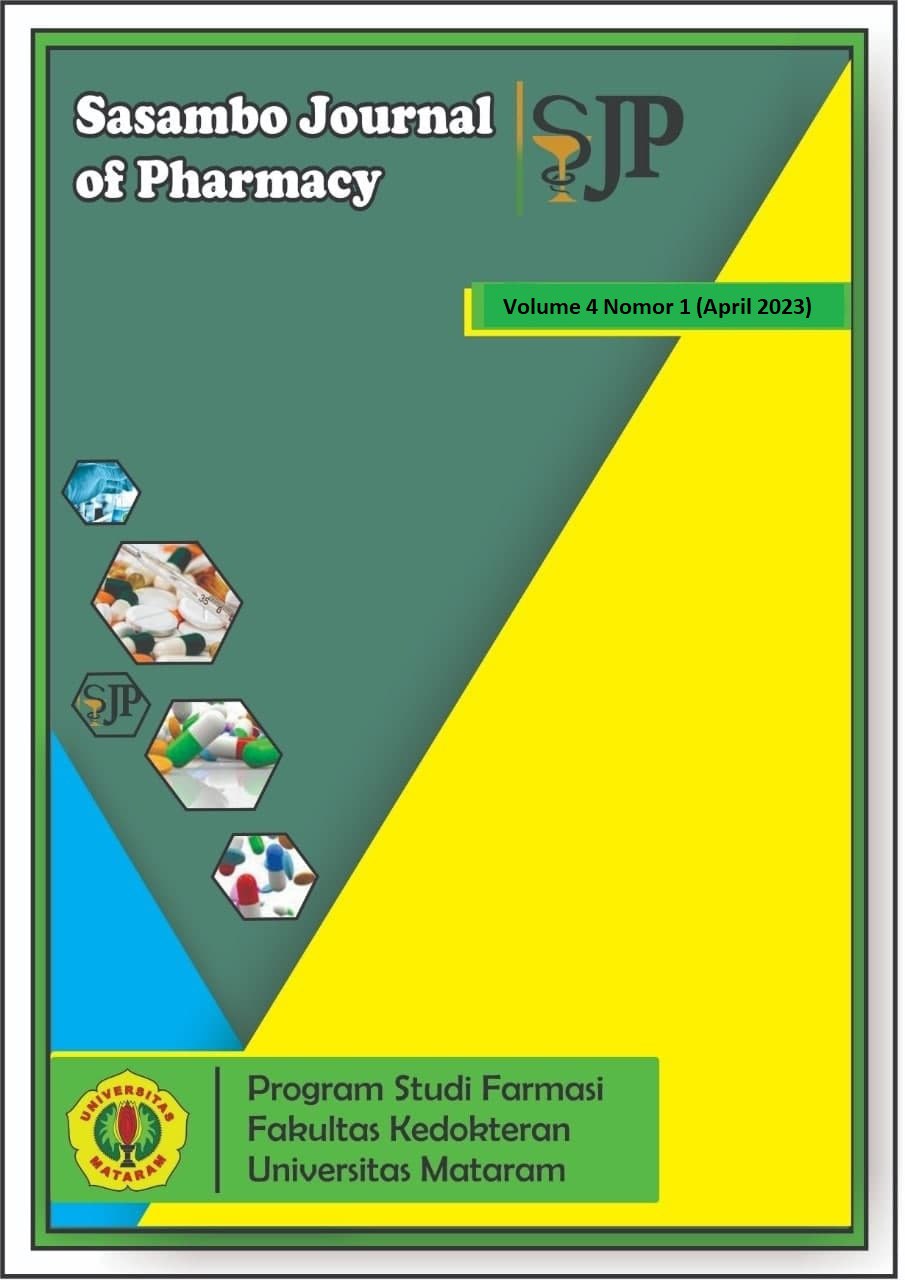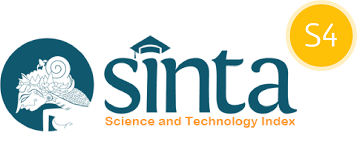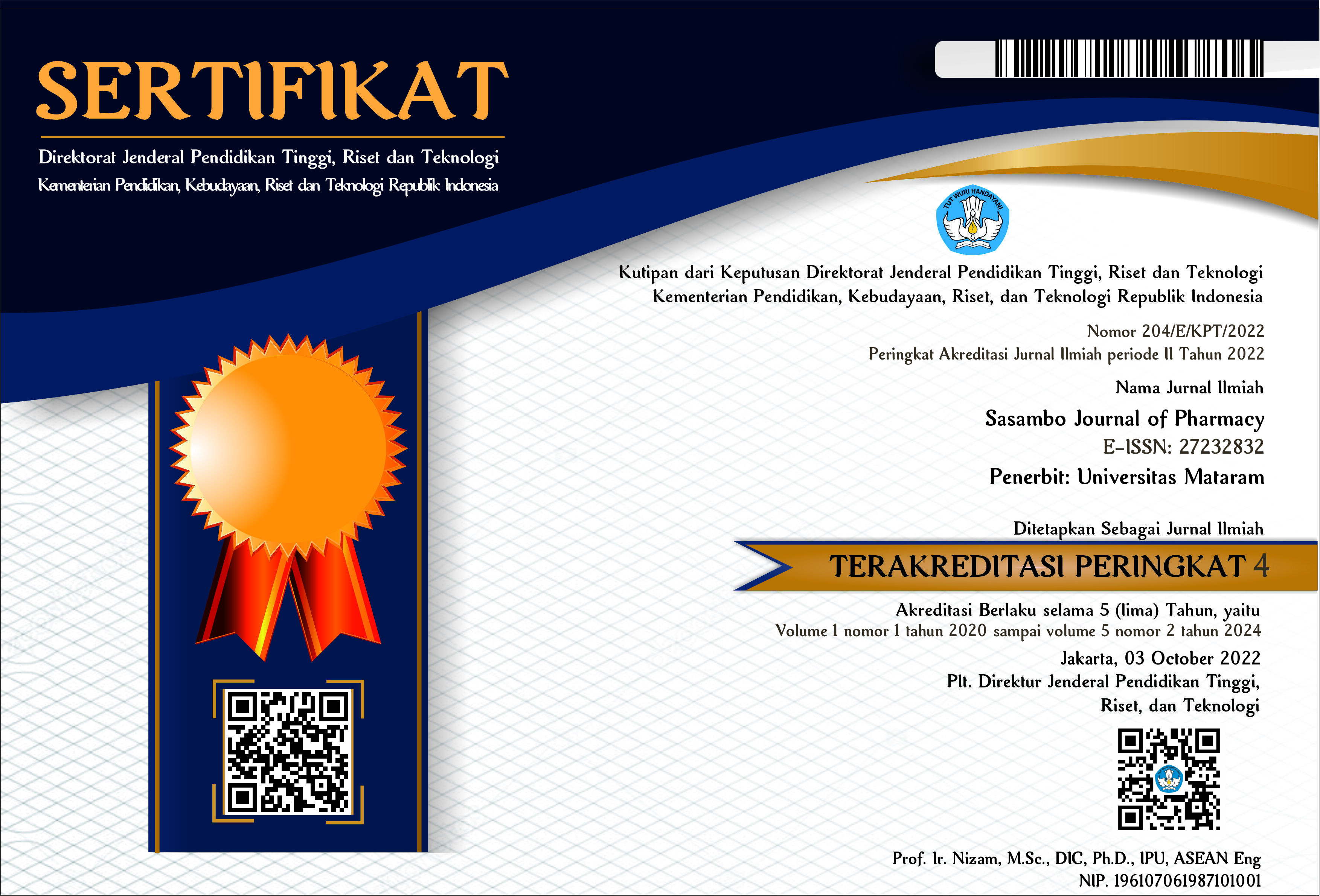Penetapan kadar vitamin C pada daun kelor (Moringa oleifera L.) dan bayam hijau (Amaranthus gangeticus L.) dengan metode spektrofotometri UV-Vis
DOI:
10.29303/sjp.v4i1.190Downloads
Abstract
Vitamin C is a compound that cannot be formed by the body itself. Vitamin C is needed to regulate metabolic processes and normal body functions. Lack of vitamin C can cause a decrease in the immune system. During a pandemic, vitamin C is needed to improve the immune system to prevent and fight disease infections. The pandemic has caused an increase in the need and price of vitamin C supplements in the market. Fulfilling the body’s vitamin C needs can use alternatives such as Moringa leaves and green spinach. This study aims to determine the levels of vitamin C in Moringa leaves and green spinach with variations in temperature and concentration. Analysis of vitamin C was carried out using UV-Vis spectrophotometry at a wavelength of 516 nm. The results of the determination of vitamin C levels in Moringa leaves and green spinach obtained the highest levels of 24,9948% and 19,0205%, and the lowest levels of 2,2456% and 1,8710%. The results of the ANOVA test showed that there was a significant difference in the levels of vitamin C obtained at the given temperature and concentration variations.
Keywords:
Vitamin C, Moringa leaves, Green spinach, UV-Vis spectrophotometryReferences
Arel, A., Martinus, B. A., & Ningrum, S. A. (2017). Penetapan Kadar Vitamin C pada Buah Naga Merah (Hylocereus costaricensis (FAC Weber) Britton & Rose) dengan Metode Spektrofotometri UV-Visibel. Scientia: Jurnal Farmasi Dan Kesehatan, 7(1), 1–5.
Badan Pengawas Obat dan Makanan. (2020). Pedoman Penggunaan Herbal dan Suplemen Kesehatan dalam Menghadapi COVID-19 di Indonesia. BPOM RI. https://www.jamudigital.com/download/BukuSakuObatHerbalSaatCovid19.pdf
Cahyati, R. D., Natsir, H., & Wahab, A. W. (2014). Analisis Kadar Asam Askorbat dalam Ekstrak Daun Kelor (Moringa Oleifera Lam) dari Daerah Pesisir dan Pegunungan Serta Potensinya Sebagai Antioksidan. Makassar: Universitas Hasanudin.
Dong, J., Ma, X., Wei, Q., Peng, S., & Zhang, S. (2011). Effects of Growing Location on the Contents of Secondary Metabolites in the Leaves of Four Selected Superior Clones of Eucommia ulmoides. Industrial Crops and Products, 34(3), 1607–1614. https://doi.org/10.1016/j.indcrop.2011.06.007
Fatimah, S., Hadju, V., Bahar, B., & Abdullah, Z. (2011). Pola Konsumsi dan Kadar Hemoglobin pada Ibu Hamil di Kabupaten Maros, Sulawesi Selatan. Makara Kesehatan, 15(1), 31–36. https://dx.doi.org/10.7454/msk.v15i1.795
Food and Drug Administration. (2020). ORA Laboratory Manual Volume II : Methods, Method Verification and Validation. US Department of Health and Human Service.
González, A. G., & Herrador, M. Ã. (2007). A Practical Guide to Analytical Method Validation, Including Measurement Uncertainty and Accuracy Profiles. TrAC Trends in Analytical Chemistry, 26(3), 227–238. https://doi.org/10.1016/j.trac.2007.01.009
Handayani, R., Dhasefa, D. A., Sari, M. W., Sukmawan, M. S., & Rofiah, N. (2020). Pembuatan Smoothies Mangga Sebagai Imun Booster Bagi Warga Kota Kulon Kabupaten Garut. Aptekmas: Jurnal Pengabdian Kepada Masyarakat, 3(4). https://doi.org/10.36257/apts.v3i4.2962
Harmita, H. (2012). Petunjuk Pelaksanaan Validasi Metode dan Cara Perhitungannya. Majalah Ilmu Kefarmasian, 1(3), 117–135. https://doi.org/10.7454/psr.v1i3.3375
Hidayah, S. N., Izah, N., & Andari, I. D. (2020). Peningkatan Imunitas dengan Konsumsi Vitamin C dan Gizi Seimbang Bagi Ibu Hamil Untuk Cegah Corona Di Kota Tegal. Jurnal ABDINUS: Jurnal Pengabdian Nusantara, 4(1), 170–174. https://doi.org/10.29407/ja.v4i1.14641
I Nengah, B. S., Ahmad, F. A., Chrysella, R., Farah, K., Fitria, F., Happy, N. E. S., Hieronimus, A. N. U., Safiinatunnajah, N.,
Wahyu, A. D., Yunita, A., & Rahem, A. (2020). Hubungan Usia dengan Pengetahuan dan Perilaku Penggunaan Suplemen pada Mahasiswa Institut Teknologi Sepuluh Nopember. Jurnal Farmasi Komunitas, 7(1), 1–7.
Kamiensky, M., & Keogh, J. (2015). Farmakologi Demystified. Rapha Publishing.
Karamoy, L. T. (2009). Hubungan Iklim Dengan Pertumbuhan Kedelai (Glycine max L Merrill). Soil Environment, 7(1), 65–68.
Kementerian Perindustrian R. I. (2019). Analisis Perkembangan Industri. Kementrian Kesehatan RI.
Mahmood, K. T., Mugal, T., & Haq, I. U. (2010). Moringa oleifera: A Natural Gift-A Review. Journal of Pharmaceutical Sciences and Research, 2(11), 775. https://www.researchgate.net/publication/289088517
Manuhara, A. (2017). Penetapan Kadar Vitamin C Pada Daun Bayam Hijau (Amaranthus Tricolor L) Segar, Rebus Dan Goreng Secara Spektrofotometri Uv-Vis. Universitas Setia Budi
Permenkes, R. I. (2013). Peraturan Menteri Kesehatan Republik Indonesia No 75 Tahun 2013 tentang Angka Kecukupan Gizi yang Dianjurkan Bagi Bangsa Indonesia. Kemenkes RI. https://peraturan.bpk.go.id/Home/Details/139226/permenkes-no-75-tahun-2013
Poedjiadi, A., & Supriyanti, F. M. T. (1994). Dasar-dasar Biokimia. Universitas Indonesia Press.
Ronis, M. J. J., Pedersen, K. B., & Watt, J. (2018). Adverse Effects of Nutraceuticals and Dietary Supplements. Annual
Review of Pharmacology and Toxicology, 58, 583–601. https://doi.org/10.1146/annurev-pharmtox-010617-052844
Rukmana, I. H. R. (1994). Bayam, Bertanam & Pengolahan Pascapanen. Kanisius.
Tahir, M., Hikmah, N., & Rahmawati, R. (2016). Analisis Kandungan Vitamin C dan β-Karoten dalam Daun Kelor (Moringa Oleifra Lam.) dengan Metode Spektrofotometri Uv–vis. Jurnal Fitofarmaka Indonesia, 3(1), 135–140. https://doi.org/10.33096/jffi.v3i1.173
Wardani, L. A. (2012). Validasi Metode Analisis dan Penentuan Kadar Vitamin C Pada Minuman Buah Kemasan dengan Spektrofotometri Uv-Visible. Universitas Indonesia.
License
Copyright (c) 2023 The Author(s)

This work is licensed under a Creative Commons Attribution 4.0 International License.
Authors who publish with Sasambo Journal of Pharmacy (SJP), agree to the following terms:
- Authors retain copyright and grant the journal right of first publication with the work simultaneously licensed under a Lisensi Creative Commons Atribusi 4.0 Internasional. This license allows authors to use all articles, data sets, graphics and appendices in data mining applications, search engines, web sites, blogs, and other platforms by providing an appropriate reference. The journal allows the author(s) to hold the copyright without restrictions and will retain publishing rights without restrictions.
- Authors are able to enter into separate, additional contractual arrangements for the non-exclusive distribution of the journal's published version of the work (e.g., post it to an institutional repository or publish it in a book), with an acknowledgment of its initial publication in Sasambo Journal of Pharmacy
- Authors are permitted and encouraged to post their work online (e.g., in institutional repositories or on their website) prior to and during the submission process, as it can lead to productive exchanges, as well as earlier and greater citation of published work (See The Effect of Open Access).







